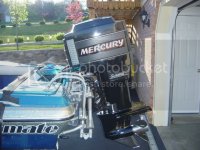hey fellas,
i just picked up a 85 checkmate exciter with a Mercury 135 motor. i don't know anything about boats or marine engines, but i can handle cars, so i hope that will help me. i've noticed that it says that it is "oil injected", what does that mean? The guy said it ran, but it overheats, water pump maybe?? What kind of gas goes in those things? Basically, what should I do before trying to start it?
thanks...
i just picked up a 85 checkmate exciter with a Mercury 135 motor. i don't know anything about boats or marine engines, but i can handle cars, so i hope that will help me. i've noticed that it says that it is "oil injected", what does that mean? The guy said it ran, but it overheats, water pump maybe?? What kind of gas goes in those things? Basically, what should I do before trying to start it?
thanks...


